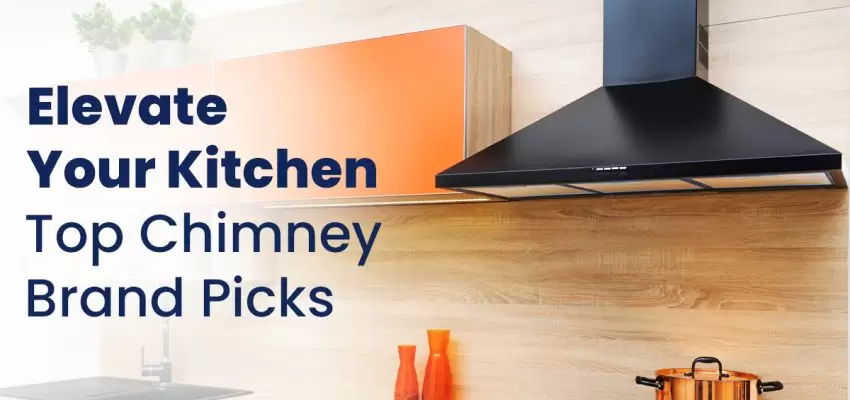When you cook and use tadka, it creates a great smell and taste, but it also leaves marks on your kitchen tiles and ceiling. A kitchen chimney helps by absorbing the fumes, freeing your kitchen from oil, smoke, and bad smells. It cleans the air in your kitchen. Let’s check out some of the best kitchen chimneys.
Post your Requirement
What Is Kitchen Chimney?
A kitchen chimney is a ventilation appliance positioned above the countertop. Operating on the principle that hot air rises, it efficiently extracts smoke, fumes, and oil particles generated during cooking. This mechanism ensures smooth air movement, given that kitchen air is warmer than the external air.
Why Is Kitchen Chimney Needed?
The benefits of installing a Kitchen Chimney are mentioned below :
- Clean Air: A kitchen chimney removes hot gases and contaminants, keeping the air cool and reducing bacteria.
- Enjoyable Cooking: Absorbs heat and steam, making cooking more comfortable and safer.
- Odor-Free: Eliminates cooking smells, preventing sneezing and coughing, and keeps the house odor-free.
- Improved Lighting: Built-in lights aid visibility while cooking, saving energy and money.
- Protects Walls: Prevents smoke and grease particles from damaging walls, tiles, and furniture.
- Aesthetic Appeal: Enhances the kitchen’s appearance, providing a sophisticated look.
- Increased Home Value: Considered a necessity and luxury, adding resale value to your home.
Different Chimney Structures
Below we have mentioned the different chimney structures:
Wall-Mounted:
- Duct fitted against the wall above the stove.
- Hob attached to the adjacent wall.
Island:
- Attached to the ceiling, away from walls.
- Hob supported to the ceiling along with the vent.
Built-in:
- Integrated into wooden furniture in the cooking space.
Corner:
- Fitted at the corner of the cooking place.
- Hob against the wall’s corner, above the cooking platform.
Kitchen Chimney Filter Types
When it comes to kitchen chimneys, variety is key. Let’s break down the main filter types:
Cassette Filter:
- Material: Aluminum mesh.
- Features: Allows easy airflow, traps oil particles, and is easy to clean.
Baffle Filter:
- Material: Small rods controlling airflow.
- Features: Curved flow pattern absorbs oil and grease, ensuring free airflow.
Carbon Filter:
- Also known as charcoal filters.
- Features: Made of charcoal mesh, excels in absorbing odor, needs replacement every six months
Top Brands Selling Chimneys in India
Leading Chimney Brands in the market are stated below:
Must-Have Features in Modern Kitchen Chimneys
Below we have listed some of the basic features necessary for Kitchen Chimneys:
- Auto-Cleaning Facility: Decide between zero or low maintenance.
- Sealed Motor: Ensure the motor is sealed to prevent smoke or dust infiltration.
- Detachable Oil Collector: Essential for collecting oil particles, keeping your kitchen grime-free.
- Minimum Noise: Opt for a quiet chimney to enhance your cooking experience.
- Filter-Less Design: Choose a chimney without filters to eliminate frequent cleaning.
- Maximum Suction Power: Ideal for heavy cooking with oils and spices, ensuring effective fume and heat absorption.
- Soft-Touch Controls: Convenient controls for easy operation.
- Energy-saving LED Lamps: Efficient lighting for your cooking area.
How Does an Electric Chimney Work?
We have mentioned the steps of how an Electric Chimney works:
- Electric chimneys work by sucking in air, unlike traditional chimneys with external ducts.
- Consisting of two parts, the exhaust hood is placed above the cooktop, and the air column connects it to the external environment.
- The hood contains a trap mesh capturing steam and smoke during cooking.
- Trapped smoke and steam are directed to the filter, which includes a primary filter and, for ductless chimneys, an extra carbon mesh.
- The filter captures oil molecules, greasy particles, and smoke.
- A motor fan rotates inside the exhaust, pushing the air into the duct for ventilation.
Considerations when purchasing a chimney for your home
Below we have listed the factors to consider while purchasing a chimney for your home:
- Chimney Type: Choose masonry, steel, or prefabricated based on your heating device.
- Size Match: Ensure the chimney size suits your appliance for efficient operation.
- Material Matters: Pick corrosion-resistant materials like stainless steel for metal chimneys; masonry can use stone or brick.
- Climate Consideration: Select materials based on your local climate.
- Usage Awareness: Factor in how often and for what purpose you’ll use the chimney.
- Efficiency Priority: Prioritize efficiency for better performance and airflow.
- Installation Expertise: Consider professional installation to ensure safety and functionality.
Conclusion
A kitchen chimney, vital for cleanliness and freshness, complements other Kitchen appliances. Ensure your kitchen, with its array of gadgets, stays clean and inviting. Cook with joy, breathe easy – thanks to the kitchen’s heart, the electric chimney.
FAQs
Q-1. Which type of kitchen chimney is best?
A-1. The best kitchen chimney type depends on your kitchen and cooking style. For Indian kitchens, ducted chimneys that take smoke outside are usually preferred.
Q-2. How useful is a chimney in the kitchen?
A-2. A kitchen chimney is very useful. It removes smoke, odors, and oil particles, keeping your kitchen clean. It also prevents health issues caused by inhaling cooking fumes.
Q-3. What are the disadvantages of a kitchen chimney?
A-3. One disadvantage is the need for regular cleaning to maintain efficiency. Ducted chimneys require proper installation, and some may make noise.
Q-4. How much electricity does a chimney consume?
A-4. Kitchen chimneys are not very power-hungry. On average, they consume about 150-200 watts per hour, similar to some light bulbs. Using energy-efficient models helps save electricity.























Post A Comment